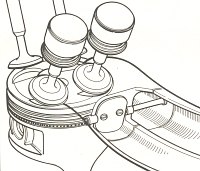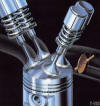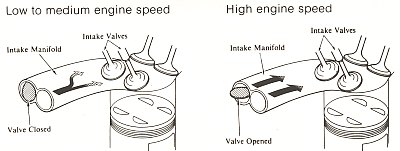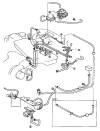 |
 |
| 2 runners, one of which is blocked by a butterfly valve | A colour picture showing the TVIS arrangement |
TVIS
What does it stand for?
Toyota Variable Induction System.
What's it there for?
It is there to "allegedly" help improve engine output power, (torque), at low rpm.
How does it do that?
Your car has 4 cylinders. Every cylinder is fed from the intake manifold. The intake manifold splits the air feed to each cylinder into 2. Therefore 4 cylinders with 2 air feeds to each cylinder equals 8 air feed "pipes" in the intake manifold.
It is a fact that if you alter the size/length/diameter of the pipes feeding the cylinders then you can increase the engines output at different rpm - gets complicated but works on reflecting pressure waves, air velocity, some times referred to as the natural supercharging effect blah blah blah. Suffice to say that at different rpm then the inlet runners need to be a different size/length/diameter to produce the maximum output power.
Toyota took advantage of this theory. The way Toyota have varied the inlet manifold to produce more power is by utilising 2 runners or "pipes" to each cylinder and blocking one off until you reach a certain engine speed - 4300rpm. Theoretically improving low rpm torque.
The arrangement looks something like this, note the blocked runner...
 |
 |
| 2 runners, one of which is blocked by a butterfly valve | A colour picture showing the TVIS arrangement |
What does it look like in real life?
Something like this...
Any more info on how the second runner is blocked off?
At the rear of the manifold are some pipes and VSVs, these serve to twist a bar that passes through the intake manifold, onto which some butterfly valves are located. Below 4300rpm the bar is twisted so that one runner to each cylinder is blocked by a butterfly valve, at 4300rpm the ECU sends a signal to the TVIS VSV and says "open up", the bar twists and the butterfly valve unblocks the runner.

In summary: below 4300rpm only 4 runners feed the cylinders, above 4300rpm all 8 runners feed the cylinders.
This is clever! Do I need it?
If the car is stock then maybe/probably, to improve torque output. The 165 and 185 GT4s were fitted with this gizmo, but this was later removed on the 205 - the latest variant of the GT4. Note - the 205 GT4 developed the most power and TVIS was ditched to help achieve this. Ask yourself the following question - if you have modified a car and want a turbo to ram as much air as possible into a cylinder, to get the most output power, why do I want to put restrictions in the way?
My turbo is making full boost well before 4300rpm, therefore the TVIS is creating an intake restriction - ditch it.
Unfortunately I do not have any evidence as to whether the TVIS helps increase output power or reduces it once the car has been modified.
The WRC 185 rally car did not utilise the TVIS system - it was removed.
I don't know. Is there any way to see what the effects are before I rip it out?
Yes. On the bottom right hand side of the manifold are two connections - one for the TPS and one for the TVIS. Pull the pipe off for the TVIS. Block the TVIS pipe and the manifold connection this will keep all the butterfly valves permanently open. Take it out for a spin - notice any difference? (you probably won't). It's worth bearing in mind that there is still a lot of crap in the intake to disturb the air flow and also the TVIS and intake manifold are way out of alignment. To put the TVIS back into operation simply reconnect the pipe you removed.
 |
 |
| TPS and TVIS connections looking from the side of the car down in between IC and plenum chamber - arrowed | The 165 engine bay pipe work layout Warning large picture! 330k |
Anything else of interest?
The TVIS butterfly valves stay open when the car is turned off. As soon as the car is started the butterflies close and will remain closed until you reach 4300 rpm; as the revs drop then the butterflies close at 3900rpm.
The fuel injectors "aim" a jet of fuel at each valve. The 2 outlets can clearly be seen from the injector picture below. Therefore, below 4300 rpm when the "flap" is shut the spray from the injector is not being carried as efficiently as possible into the cylinder.
I think I'm up for ditching my TVIS! Got any tips on how to do it?
Have a look at this article...